Online freelance marketplace Fiverr (NYSE:FVRR) reported Q1 CY2024 results exceeding Wall Street analysts' expectations, with revenue up 6.3% year on year to $93.52 million. The company expects next quarter's revenue to be around $94.5 million, in line with analysts' estimates. It made a non-GAAP profit of $0.52 per share, improving from its profit of $0.36 per share in the same quarter last year.
Fiverr (FVRR) Q1 CY2024 Highlights:
- Revenue: $93.52 million vs analyst estimates of $92.47 million (1.1% beat)
- EPS (non-GAAP): $0.52 vs analyst estimates of $0.45 (15.2% beat)
- Revenue Guidance for Q2 CY2024 is $94.5 million at the midpoint, roughly in line with what analysts were expecting
- The company reconfirmed its revenue guidance for the full year of $384 million at the midpoint
- Gross Margin (GAAP): 83.5%, up from 82.2% in the same quarter last year
- Free Cash Flow of $20.8 million, down 24.1% from the previous quarter
- Active Buyers: 4 million, down 300,000 year on year
- Market Capitalization: $786.4 million
Based in Tel Aviv, Fiverr (NYSE:FVRR) operates a fixed price global freelance marketplace for digital services.
Fiverr operates a global digital services marketplace in over 450 categories including graphic design, digital marketing, translation and programming. The company operates in over 160 countries, with roughly 2/3rds of its business taking place in English-speaking countries.
The value proposition for buyers of “gigs” is multi-part: access to an expansive catalog of digital services and a diverse pool of freelancers, price certainty for clearly defined services, and the knowledge that Fiverr will regulate any disputes between buyers and sellers of services.
For gig sellers, Fiverr provides an audience and digital storefront to list their services. By reducing the need to source a pipeline of new projects, freelancers can focus on execution. The fixed price element removes the need for negotiating with buyers. Fiverr also provides the business support infrastructure for freelancers, such as standardized contracts, invoicing and payment, financial reporting, marketing and real-time performance feedback along with a customer support function.
Gig Economy
The iPhone changed the world, ushering in the era of the “always-on” internet and “on-demand” services - anything someone could want is just a few taps away. Likewise, the gig economy sprang up in a similar fashion, with a proliferation of tech-enabled freelance labor marketplaces, which work hand and hand with many on demand services. Individuals can now work on demand too. What began with tech enabled platforms that aggregated riders and drivers has expanded over the past decade to include food delivery, groceries, and now even a plumber or graphic designer are all just a few taps away.
Fiverr (NYSE:FVRR), competitors include Meta Platforms (NASDAQ:META), Upwork (NASDAQ:UPWK), Microsoft’s LinkedIn (NASDAQ:MSFT) and privately held Freelancer.
Sales Growth
Fiverr's revenue growth over the last three years has been solid, averaging 19.6% annually. This quarter, Fiverr beat analysts' estimates but reported mediocre 6.3% year-on-year revenue growth.
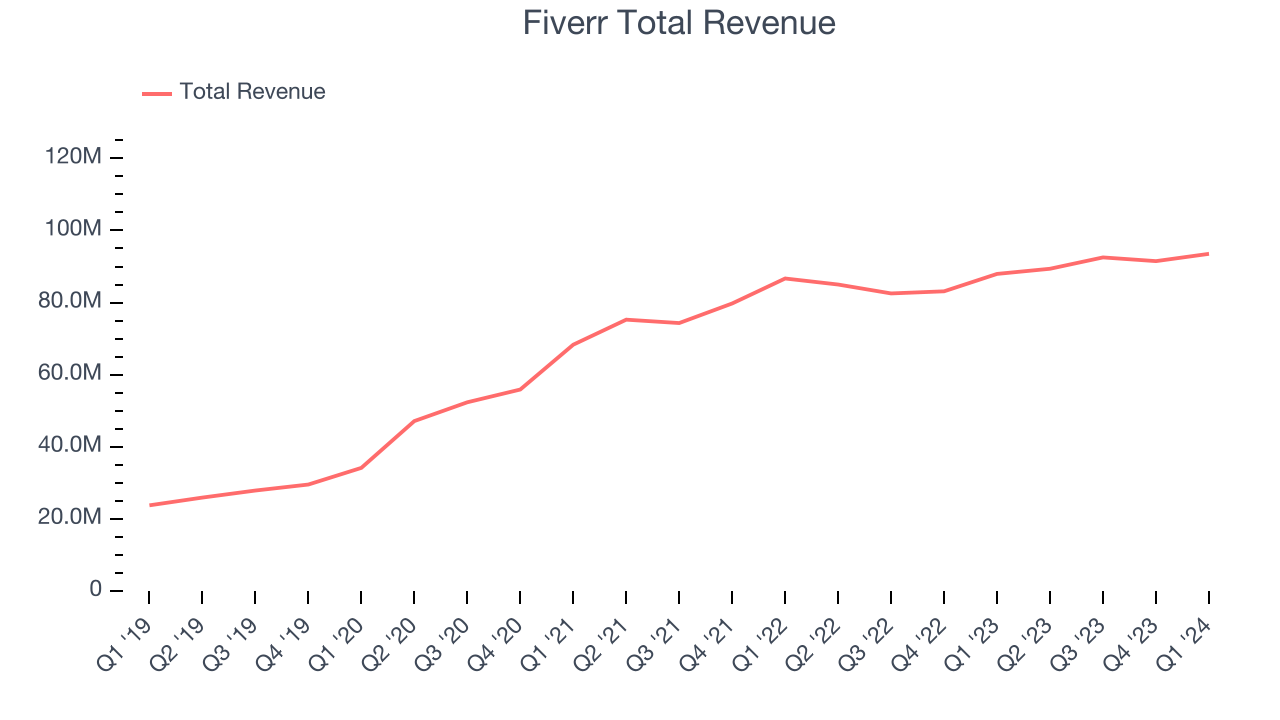
Guidance for the next quarter indicates Fiverr is expecting revenue to grow 5.7% year on year to $94.5 million, improving from the 5.1% year-on-year increase it recorded in the comparable quarter last year. Ahead of the earnings results, analysts were projecting sales to grow 5.8% over the next 12 months.
Usage Growth
As a gig economy marketplace, Fiverr generates revenue growth by expanding the number of services on its platform (e.g. rides, deliveries, freelance jobs) and raising the commission fee from each service provided.
Over the last two years, Fiverr's active buyers, a key performance metric for the company, grew 0.1% annually to 4 million. This is one of the lowest rates of growth in the consumer internet sector.
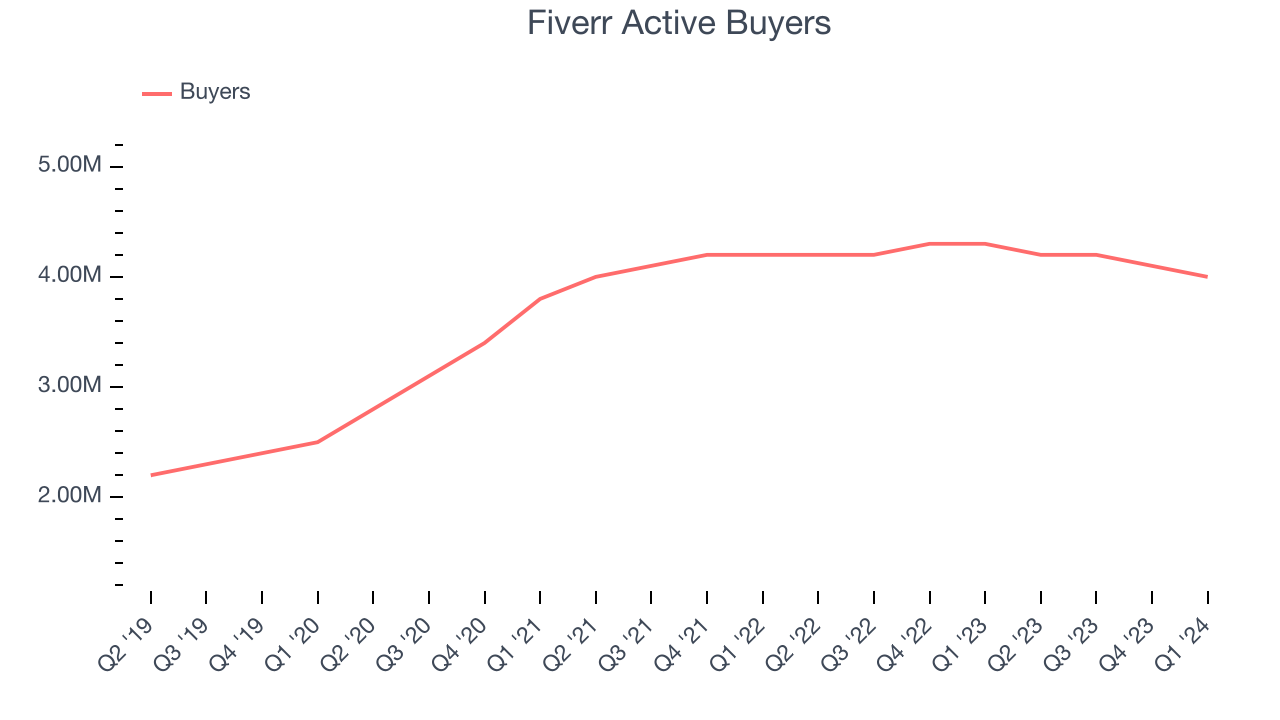
Unfortunately, Fiverr's active buyers decreased by 300,000 in Q1, a 7% drop since last year.
Revenue Per Buyer
Average revenue per buyer (ARPB) is a critical metric to track for consumer internet businesses like Fiverr because it measures how much the company earns in transaction fees from each buyer. This number also informs us about Fiverr's take rate, which represents its pricing leverage over the ecosystem, or "cut" from each transaction.
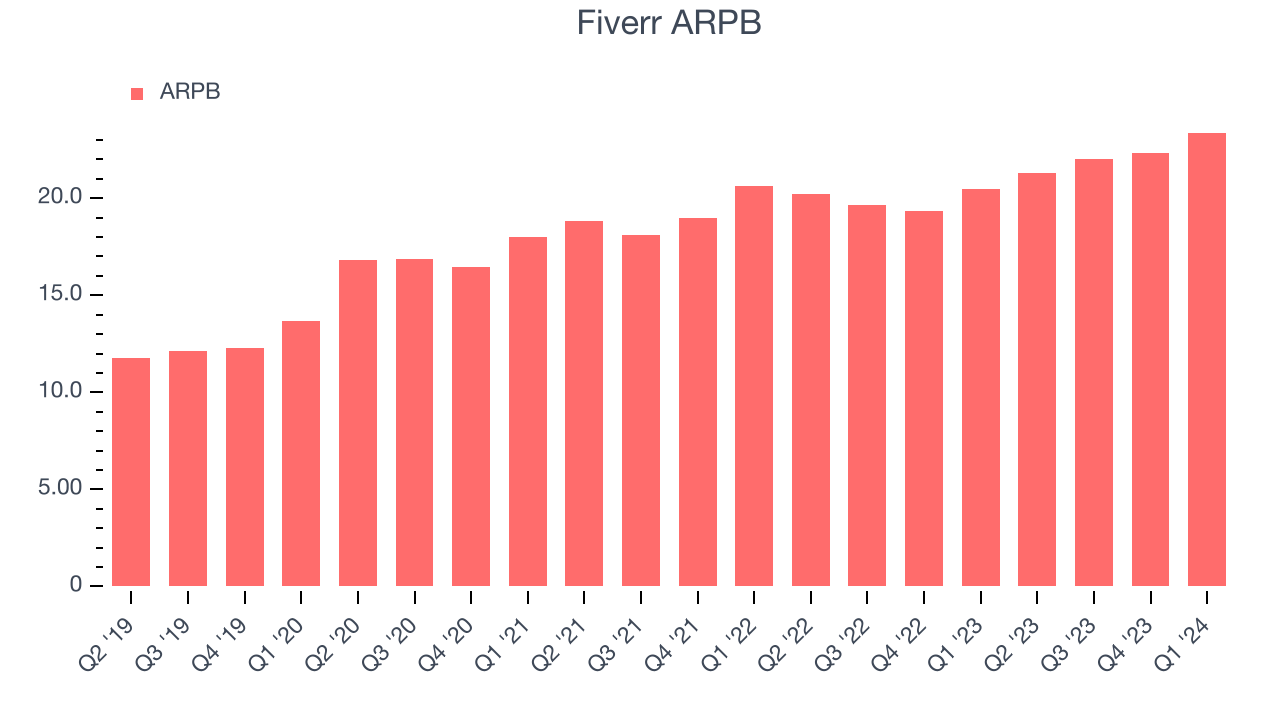
Fiverr's ARPB growth has been decent over the last two years, averaging 8%. The company's ability to increase prices while growing its active buyers demonstrates the value of its platform. This quarter, ARPB grew 14.3% year on year to $23.38 per buyer.
Pricing Power
A company's gross profit margin has a major impact on its ability to exert pricing power, develop new products, and invest in marketing. These factors may ultimately determine the winner in a competitive market, making it a critical metric to track for the long-term investor.
Fiverr's gross profit margin, which tells us how much money the company gets to keep after covering the base cost of its products and services, came in at 83.5% this quarter, up 1.3 percentage points year on year.
For gig economy businesses like Fiverr, these aforementioned costs typically include server hosting, customer support, and payment processing fees. Another cost of revenue could also be insurance to protect against liabilities arising from providing transportation, housing, or freelance work services. After paying for these expenses, Fiverr had $0.83 for every $1 in revenue to invest in marketing, talent, and the development of new products and services.
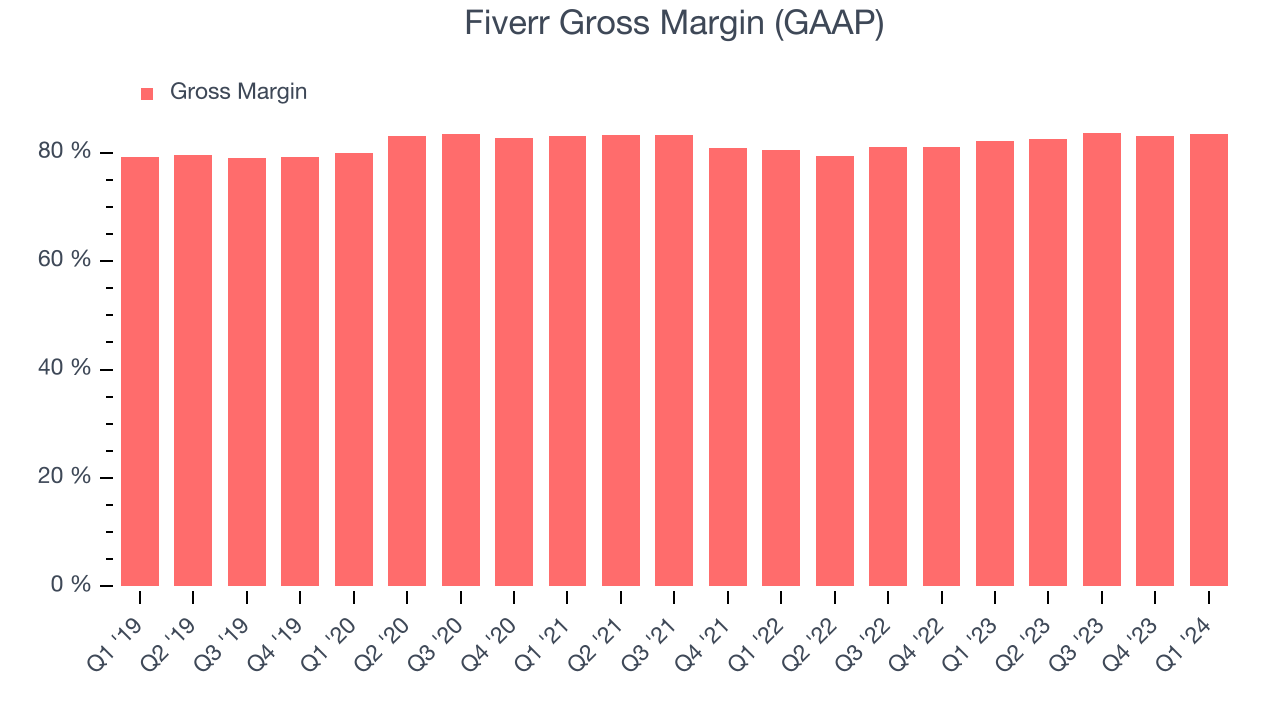
Fiverr's gross margins have been trending up over the last 12 months, averaging 83.2%. Its margins are some of the highest in the consumer internet sector, enabling it to fund large investments in product and marketing during periods of rapid growth to stay one step ahead of the competition.
User Acquisition Efficiency
Consumer internet businesses like Fiverr grow from a combination of product virality, paid advertisement, and incentives (unlike enterprise software products, which are often sold by dedicated sales teams).
It's expensive for Fiverr to acquire new users as the company has spent 52.8% of its gross profit on sales and marketing expenses over the last year. This relative inefficiency indicates that Fiverr's product offering can be easily replicated and that it must continue investing to maintain its growth trajectory.
Profitability & Free Cash Flow
Investors frequently analyze operating income to understand a business's core profitability. Similar to operating income, adjusted EBITDA is the most common profitability metric for consumer internet companies because it removes various one-time or non-cash expenses, offering a more normalized view of a company's profit potential.
This quarter, Fiverr's EBITDA came in at $16.02 million, resulting in a 17.1% margin. Furthermore, Fiverr has shown strong profitability over the last four quarters, with average EBITDA margins of 17.4%.
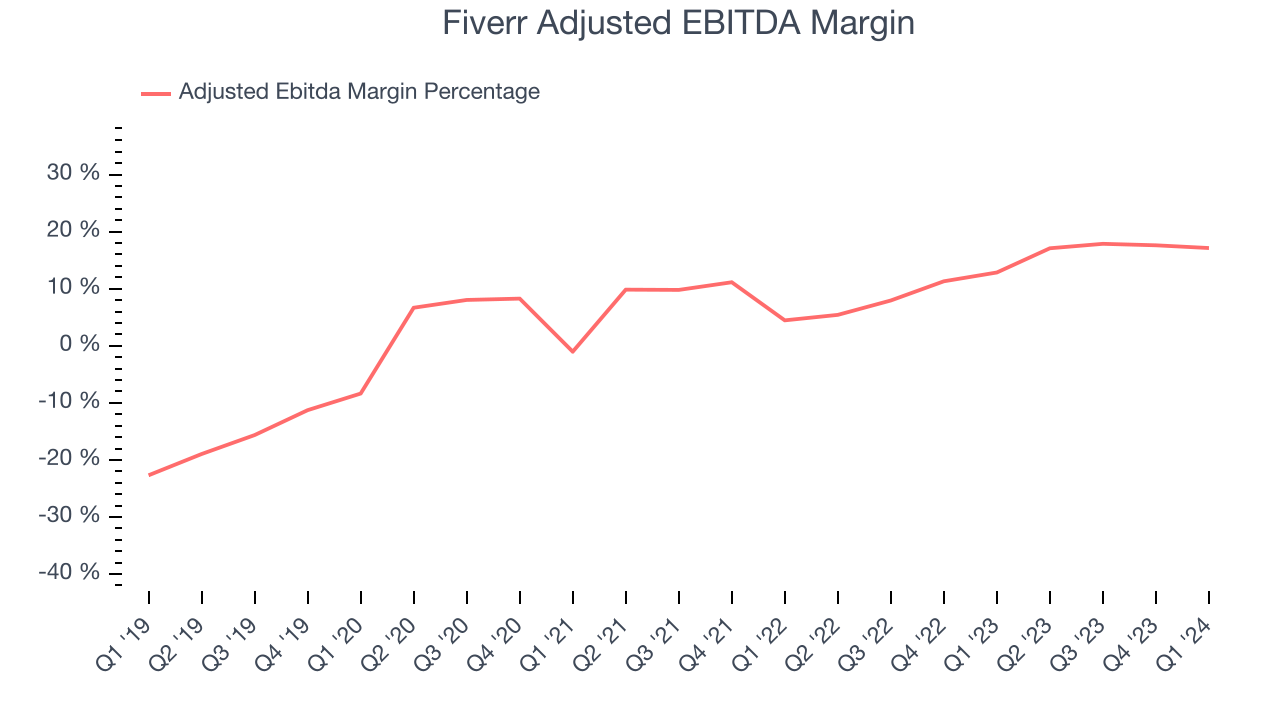
If you've followed StockStory for a while, you know that we emphasize free cash flow. Why, you ask? We believe that in the end, cash is king, and you can't use accounting profits to pay the bills. Fiverr's free cash flow came in at $20.8 million in Q1, up 57.9% year on year.
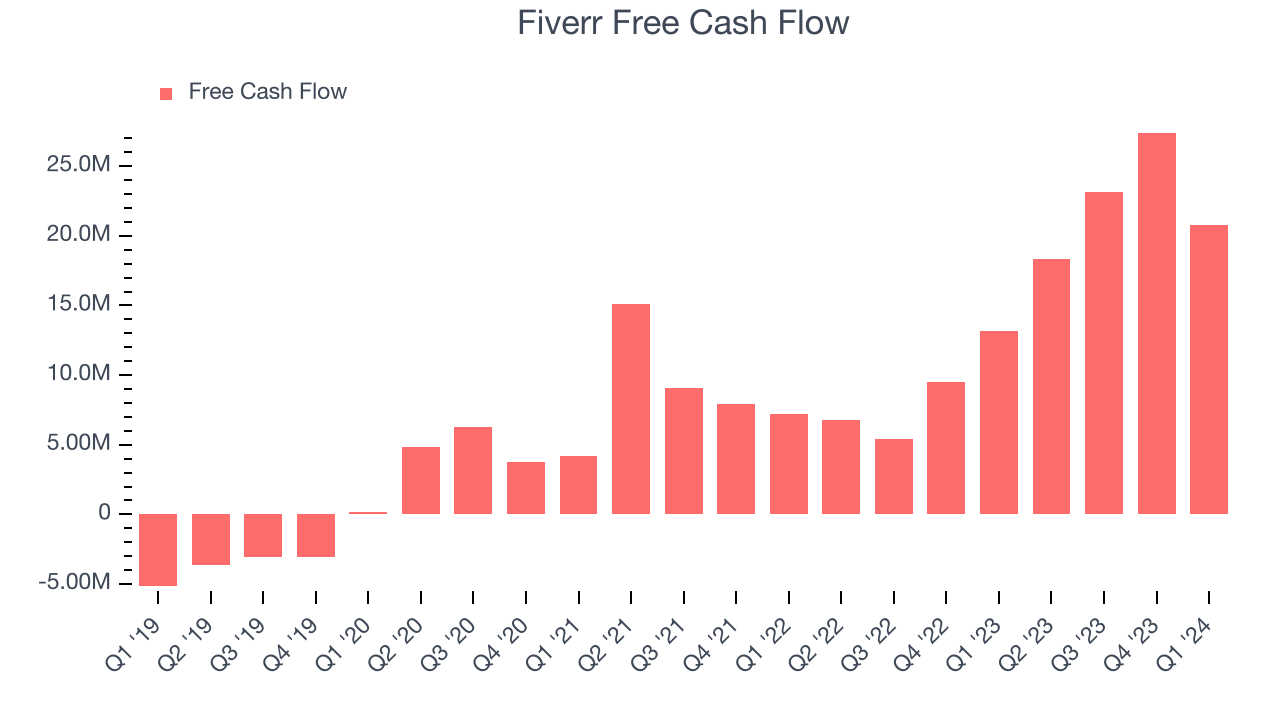
Fiverr has generated $89.76 million in free cash flow over the last 12 months, an eye-popping 24.5% of revenue. This robust FCF margin stems from its asset-lite business model and scale advantages, giving it the option to return capital to shareholders or reinvest in its business while maintaining a healthy cash balance.
Key Takeaways from Fiverr's Q1 Results
It was good to see Fiverr narrowly top analysts' revenue expectations this quarter. On the other hand, its number of buyers declined and its revenue growth was quite weak. Overall, this was a bad quarter for Fiverr. The stock is up 5.8% after reporting and currently trades at $21.49 per share.
Is Now The Time?
Fiverr may have had a tough quarter, but investors should also consider its valuation and business qualities when assessing the investment opportunity.
We think Fiverr is a solid business. We'd expect growth rates to moderate from here, but its revenue growth has been solid over the last three years. And while its active buyers have declined, the good news is its impressive gross margins are a wonderful starting point for the overall profitability of the business. On top of that, its powerful free cash flow generation enables it to stay ahead of the competition through consistent reinvestment of profits.
At the moment, Fiverr trades at 11.5x next 12 months EV-to-EBITDA. There are definitely things to like about Fiverr and looking at the consumer internet landscape right now, it seems that the company trades at a pretty interesting price.
Wall Street analysts covering the company had a one-year price target of $30.90 per share right before these results (compared to the current share price of $21.49), implying they saw upside in buying Fiverr in the short term.
To get the best start with StockStory check out our most recent Stock picks, and then sign up to our earnings alerts by adding companies to your watchlist here. We typically have the quarterly earnings results analyzed within seconds of the data being released, and especially for the companies reporting pre-market, this often gives investors the chance to react to the results before the market has fully absorbed the information.
